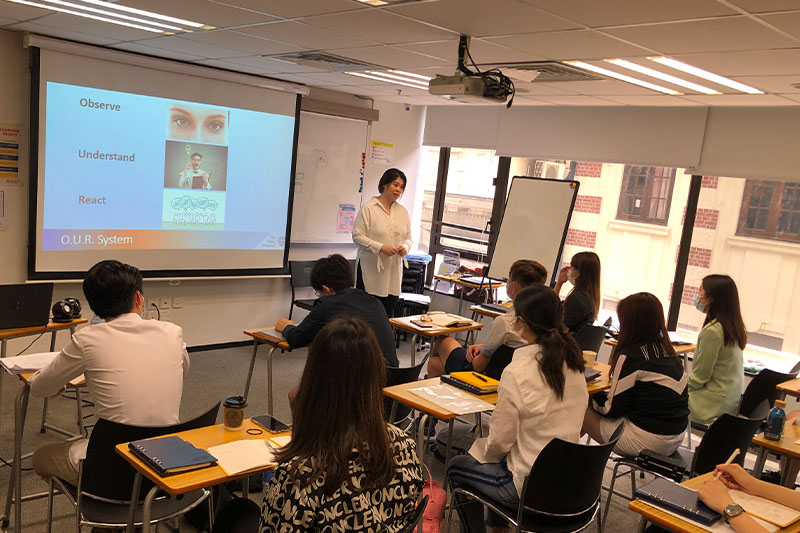Non-verbal communication is just as, if not more important, than verbal communication. Two body language specialists weigh in on how you can improve your professional relationships.
As the saying goes, “Actions speak louder than words”. Indeed, research actually shows that non-verbal communication makes up a whopping 93% of our communication.
Non-verbal communication is a crucial part of our work life. Not only does it allow you to make a strong impression – whether that’s with an important client or with your boss, it also helps you to form more meaningful connections with your coworkers and clients. In short, non-verbal communication forms the backbone of all relationships in the workplace.
Having good non-verbal communication skills, however, is more complicated than it seems. A complex craft, everything and anything from your body language to your facial expressions and tone of voice sends out non-verbal indicators to others around you. Keeping track of all this – and adapting to your surroundings at the same time – can be a daunting task.
Here, we talk to body language training specialists Kiki Wong and Anthony Tsang, founders of The Silent Company, about how you can improve your non-verbal communication at work.

1. Project Positive Body Language
For starters, Kiki and Anthony stress the importance of a smile in the workplace – even when you don’t feel like smiling. Not only does it make a good first impression, but it also makes you more approachable. “You will be surprised at what you can get away with if you look friendlier,” Anthony laughs.
Projecting positive body language is important even during COVID-19, when the bottom half of your face may be hidden under a mask. “You can still sense whether someone is smiling or staring at you angrily through their eyes. It’s just a completely different feeling,” Anthony elaborates.
2. Actively Evaluate Your Non-Verbal Skills
It’s easy to spot flaws in others, but it’s just as important to recognise our own bad habits in order to improve our non-verbal communication skills.
Anthony and Kiki suggest filming yourself when practising a presentation or a pitch and playing back the footage – a technique The Silent Company also uses with its clients. By taking a step back, you’re more likely to notice sub-optimal elements of your non-verbal communication, such as bad posture, sudden angry facial expressions, or a lack of articulation.
3. Seek Connection with Others
Communication is a two-way street – one that you can foster by putting more effort into understanding the ins and outs of your clients and colleagues.
“Put some time into researching who you’re about to see, even if it’s just a photo of that person. It might give you a better indication of how you should interact with them,” Kiki advises. For example, “If there is a photo of this person with lots of cats around them, you can subtly drop in cat-related topics during the meeting, if appropriate, to build a connection with that person.”
4. Adapt Your Body Language to Your Surroundings
When you meet new clients or step into the office on your first day of work, be sure to observe your surroundings and adapt accordingly to the overall vibe.
“From the moment I stepped into your office, I gathered that this is a casual, open office with green plants everywhere, and the people working here are quite young,” Kiki shares her own first impressions of the Hive Central as an example. “That naturally affects my own actions – I’d present myself to be more energetic and bubbly to fit into the environment rather than act old and serious.”
5. Use Visual Language
“Close your eyes and think about one memorable scenario. It could be something that made you really happy, sad, or angry. Now tell me, did you visualise that situation happening, hear the sounds, or actually feel the emotions you experienced at the time?” Kiki asks.
When it comes to recalling and processing memories, “A majority of people – 75% – are visual, 20% are auditory, while only 5% base it on feelings,” Kiki elaborates. Incorporating visual language in your everyday vocabulary will, therefore, help you connect with more people easily. For instance, rather than asking, “How are you feeling today?”, which is more emotive, revise your question to “How was your day today?” or bring in visuals such as commenting on their appearance or the weather.
On the flip side, if you notice the person you’re working tends to use more auditory terminology, you should reciprocate with the same kind of language, using phrases such as “It sounds nice” or “It rings a bell”. Adapting to the other person’s preferred mode of communication thus makes it easier to connect with others.

6. Practice Active Listening for Better Engagement
In a workplace, there is nothing worse than feeling like you’re talking to a brick wall. Instead, employ active listening techniques such as maintaining eye contact. According to Anthony, this should involve looking away briefly 25% of the time, so as not to make the other person feel uncomfortable. He also advises supplementing this with small gestures like a little nod or a head tilt.
Particularly as digital communication becomes more common amidst COVID-19 and remote working, these non-verbal cues that show you’re actively listening take on an increasingly important role. Kiki elaborates, “People tend to just stare and look at the screen, but if you don’t make a sound, the other person won’t be sure whether you’re actually listening, if you’re distracted by something on your screen, or if the screen is frozen.”
7. Be Responsive to Other People’s Behaviour
“The O.U.R. System” stands for three actions: observe, understand, and react. At the heart of non-verbal communication is your ability to recognise situations, evaluate them, and act accordingly.
“When you see someone fidgeting, whether they’re playing with their hair, their necklace, or their earrings, this is a sign they are getting uncomfortable about the topic. This can act as a warning sign for you to change the conversation topic, or it might be a green light for you to push the conversation forward to get to the truth,” Kiki explains.
Other times, when you know your audience may not be familiar with the topic or the terminology you’re talking about, Anthony advises speaking slower and clearer, especially during an interview.
8. Appear Professional – Even Virtually
Finally, as virtual communication becomes increasingly normalised, it’s important not to forget the fundamentals of appearing professional, which will benefit all your non-verbal communication efforts.
When video calling, “A very simple tip would be to elevate your laptop,” Anthony advises. “Put your laptop on a box and have your screen tilted downwards at a slight angle. This angle is much more flattering than shooting up your nostrils, and puts you at a similar eye level as the other person.”
You also want to be mindful of your audio quality – there is nothing worse than bad audio when you are not even able to get the message across. “Using a plugged-in microphone rather than your laptop microphone makes a huge difference,” suggests Anthony.
All in all, be sure to apply all these tips to your non-verbal communication and you will no doubt start making better first impressions, forging stronger professional relationships, and putting your best foot forward.
Related Articles
Work Culture in Japan: The 5 Crucial Differences You Should Know About





